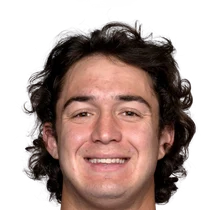The maven of ‘Moneyball’ returns to a whole new game. Can he catch up?

LAS VEGAS — When Paul DePodesta walked away from baseball 10 years ago, Washington Nationals president of baseball operations Paul Toboni was finishing up an internship with the Boston Red Sox. Elsewhere, Los Angeles Dodgers general manager Brandon Gomes was trying to extend his pitching career with the Chicago Cubs, and Buster Posey was the catcher for the San Francisco Giants, not its president of baseball operations.
A lot can change in a decade.
The sport has undergone a transformation since DePodesta, the new Colorado Rockies president of baseball operations, left the New York Mets front office to work for the Cleveland Browns. Once a maven of the Oakland Athletics’ ‘Moneyball’ era, DePodesta watched from afar as Major League Baseball underwent the launch-angle revolution, battled the sign-stealing scandals and experienced the proliferation of pitch shaping, the crackdown on sticky stuff and the implementation of the pitch clock.
To get a sense for how much the landscape has shifted, The Athletic asked executives gathered at MLB’s general managers’ meetings to answer a question: Are there things about baseball that you believed in 10 years ago but no longer believe to be true?
“Of course!” Cleveland Guardians president of baseball operations Chris Antonetti said. “I would hope everybody would answer that the same way. If we’re not all continually learning and evolving, then the game’s going to pass us by.”
Antonetti is one of the executives who has kept in touch with DePodesta over the years. DePodesta said his friendships helped him keep tabs on baseball while working as the chief strategy officer for the Cleveland Browns.
“They would hit me up for things that were happening in the NFL and maybe would spur some ideas for what they were doing,” he said. “But I would always try to keep abreast of what was happening in baseball. I mean, certainly not to the extent that I was when I was working full time.”
While addressing reporters Tuesday, DePodesta outlined his primary focus as canvassing the Rockies organization to foster an inclusive culture for the rebuilding effort. Yet Colorado is considered by other organizations to be an intellectual backwater lacking the technology and infrastructure that teams consider essential to compete. So DePodesta must also get up to speed on what, exactly, he might have missed during his time away. The answers, as provided by his fellow chief baseball executives, touched upon player development, evaluation and day-to-day strategy.
Arizona Diamondbacks general manager Mike Hazen pointed to the propensity for elite prospects to rocket through the minor leagues. “Ten years ago, I didn’t think a high school kid could come up in two years and play in the big leagues,” he said. “And now I don’t believe that anymore.”
Jackson Holliday was drafted with the No. 1 pick in 2022, then debuted at 20 years old in 2024. (Duane Burleson / Getty Images)
In recent years, players such as Kansas City Royals shortstop Bobby Witt Jr., Boston Red Sox outfielder Roman Anthony and Washington Nationals outfielder James Wood have all debuted at 21. Baltimore Orioles infielder Jackson Holliday topped them all by reaching the majors at 20.
“There’s more opportunity for younger players in the game,” Hazen said. “I think the skills of younger players coming into the game is higher than it was. The training that they do in the offseason is more specialized for their age. They may be better baseball players than they used to be.”
The opportunity to improve those players does not end when they reach the majors. The concept of development at the big-league level has become more common in recent years, an approach taken to the extreme by organizations like the Miami Marlins.
“We’ve gotten so much better at development and accelerating development,” Texas Rangers president of baseball operations Chris Young said. “The resources, the technology, the data, the infrastructure that teams now have — you have to win at the margins. Because everybody’s too good, if you don’t.”
And the pool of people providing the instruction has widened. Last week, the Chicago White Sox hired Derek Shomon, a 35-year-old whose playing career ended after a handful of games in independent ball, as a hitting coach. The hiring of someone like Shomon would have caused a stir during the playing career of White Sox general manager Chris Getz, who retired in 2014.
“I thought coaches had to have a playing background to be effective,” Getz said. “I would say that’s probably the biggest change. That would be very surprising to hear 10 years ago.”
The lack of a big-league resume matters less because the nature of coaching has changed. The most intense adjustments have occurred on the pitching side, executives said. The timeworn concepts of “establishing the fastball” or “disrupting the hitter’s timing” have been displaced by technical terminology that might sound confounding to the uninitiated.
“You can talk to a minor-leaguer now — they’ll tell you their induced vertical break and their horizontal break and what their extension is,” Gomes said. “They can rattle it all off like it’s ERA.”
DePodesta departed for the NFL just as hitters such as J.D. Martinez and Justin Turner were altering their swings to aim for the fences and thus altering the trajectories of their careers. In time, that same adaptability has become possible for pitchers.
“Ten years ago, my understanding from people who I think are really smart is that a lot of the qualities of a pitcher are fixed,” Marlins president of baseball operations Peter Bendix said. “(It was thought to be) very difficult to improve ‘fill in the blank’: velocity, spin rate, breaking balls, command. I no longer believe those things are true. I think pitchers can and do improve a number of different components of their game.”
Jalen Beeks is one of several players who improved well into his 20s. (Chris Coduto / Getty Images)
Bendix pointed to Jalen Beeks, a reliever acquired by the Tampa Bay Rays back when Bendix worked there in 2018. The organization revamped his delivery and watched him improve.
“Ten years ago, if you had told me you could change someone’s arm action in the big leagues and make them better, I would have said, ‘No way,’” Bendix said. “And I don’t think Jalen is the only one.”
The source of much of this progress stems from data. So much can be measured and contextualized in this era: the RPMs on a curveball, the exit velocity on a line drive, the ground covered by an outfielder. The refinement of fielding data has plugged holes in the evaluation process, Antonetti said.
“We can measure things on the defensive things now that we were not measuring 10 years ago,” Antonetti said. “It substantiates and helps you put a value on the relative weights of offense, defense, base running, things like that, which were much more difficult to assess 10 years ago.”
Back then, Minnesota Twins president of baseball operations Derek Falvey was an assistant general manager in Antonetti’s front office. He agreed with his former boss about the influx of new data helping provide more accurate evaluations at the big-league level. But a more profound change, Falvey explained, occurred with the use of technology like the TrackMan radar system.
“We can be actually more objective about the minor leaguers, too, because we have tracking systems and data, and we’re better at projecting those players as a result,” Falvey said. “So we have the scouting information, blend in the data that we have. We’re more accurate when we blend them. And that stuff didn’t exist 10 years ago in the minor leagues.”
During these interviews, executives were quick to suggest DePodesta could catch up to speed. “He’s so bright; he’s successful,” Atlanta Braves president of baseball operations Alex Anthopoulos said. “He’s in professional sports. Once you work in baseball, you’re a baseball fan. You’re always following it.”
Baltimore Orioles president of baseball operations Mike Elias suggested DePodesta’s experience in the NFL could aid the Rockies in one of baseball’s less-charted frontiers.
“So much of our areas of growth and opportunity are in that player health and performance space right now,” Elias said. “And other sports are potentially either ahead of us or just have some things to add there.”
The Rockies will need some innovation. The foremost challenge for DePodesta will be building a pitching staff that can survive at the high altitude of Coors Field. In order to succeed, DePodesta must do more than absorb all the things he missed. He must chart a path toward where the game is going.
“Paul is brilliant,” Antonetti said. “He’s someone who has continued to be plugged into baseball. It’s not like he fell off the earth and went and lived in a place where baseball wasn’t broadcast.”





